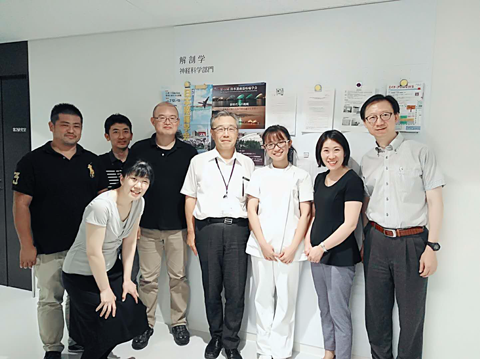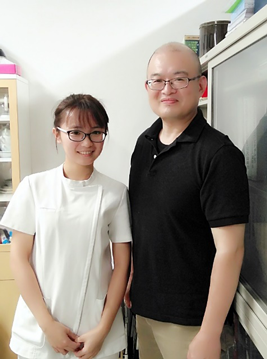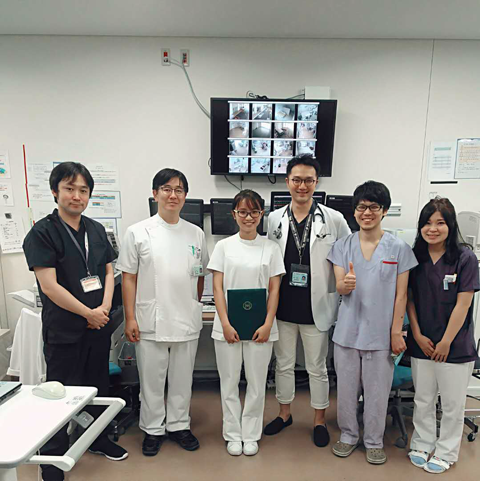国際・国内交流
陈文婷(Chen Wenting)さん(汕頭大学医学院第4学年次)
Report of experiences at Hyogo College of Medicine
Preface
It took us about one hour from Kansai International Airport to Hyogo College of Medicine by taxi. Torii-san, a teacher from Center for International Programs, gave us a warm welcome after picking us up at the airport. She took us to the guesthouse, arranged everything well for us, and showed us around.
The blue sky, the fine weather, the tidy streets and the local Japanese house all impressed me a lot. I did come to Japan! Later, I was flattered that four students who came to Shantou University Medical College last year treated us a delicious Kushinoya. They were so outgoing and warm-hearted that we all had a great time that night!
And then, my four weeks at Hyogo College of Medicine began.
Basic Department——Anatomy and Neuroscience
Because of my great interest in Neuroscience and mechanism of pain, I chose the Department of Anatomy and Neuroscience. The first day I was so nervous that I even didn’t introduce myself to the department. I had prepared the introduction in Japanese and English before. However, everyone in the department were so nice to me. Professor Noguchi introduced the history, present and the future of the study of pain. My main teacher was Yamanaka-sensei. He explained the experiment we would do during two weeks. In the afternoon, I observed the anatomy and fixation of rat spinal cord. Our experiment would begin the next day!
| Name of Experiment | Double fluorescence immunohistochemistry analysis of spinal cord of rat receiving peripheral nerve injury |
| Sample | SD male rat receiving sciatic injury (28 days) Formaldehyde fixed spinal cord thickness 25μm free-floating section |
| Antibodies |
1. anti-calcitonin gene-related peptide(CGRP)antibody + anti Neurofilament 200(NF-200) antibody 2. anti CGRP antibody + anti synaptophysin antibody 3. anti Galanin antibody + anti synaptophysin antibody |
| Microscope | OLYMPUS FV1200 |
The next day morning, under the introduction of Yamanaka-sensei, I started to prepare the sample. It was not an easy work. I failed at the first time. Thanks to Yamanaka –sensei’s patience and encouragement, I succeeded and did a good job.
After sectioning, I did the washing, adding with pipettes, calculating, waiting. timing, and preparing the slides again and again during the rest of time of experiment. The procedures were not difficult. However, you were required to be patient, careful and good at calculating.
Our experiment used three kinds of double antibodies to analyze the spinal cord of rat receiving peripheral nerve injury. When all the slides had prepared, we used microscope to observe the staining.
During the free time in the department, chatting with members of department was a joy for me. It was so nice of them to prepare a welcome dinner for me, which made me feel at home. We shared the differences between China and Japan with each other. They would worry my health after knowing that I ate little for dinner and even gave me a box of spicy instant noodles when I said I enjoyed spicy food. They would like to introduce delicious restaurants and places of interests to me. To ensure that I could understand, they would try their best to explain every detail for me. I appreciated everything they did for me a lot. Thanks to them, I had a further understanding of Japanese culture.
I really learned a lot during these two weeks in the basic department. I realized that doing scientific research not only could serve as a bridge between theory and practice, but it was also a challenge for every medical student, because it did need researcher to be persistent,creative, patient, peaceful and careful. I would try my best effort to become such kind of person.
Clinical Department——Coronary Heart Disease
I spent the next two weeks in the clinical department, and because I liked the heart, I chose the Department of Coronary Heart Disease. The first day I came to the department was still very uneasy. After all, it was a new place. Fortunately, the kindness of my first teacher, Goda-sensei relieved my nervousness. She prepared very detailed maps and arrangements for these two weeks, and showed me to the places
The two weeks in the Department of Coronary Heart Disease could be divided into two parts. One was to observe and learn several kinds of operations and examination under the guidance of different teachers, such as transesophageal echocardiography (TEE) pacemaker parameters setting of patient treated with cardiac resynchronization therapy(CRT), Scintigraphy, Coronary Angiography and Intervention, Treadmill Exercise Stress Electrocardiogram and Catheter Ablation. The other one was studying in CCU. Teachers in CCU would analyze the patient's condition with me, and we would discuss the main treatment principles and medications for some diseases, such as myocardial infarction, heart failure, angina pectoris, pulmonary embolism and so on. What’s more, if there was any operation or surgery, they would let me know and explain it to me, like the tracheotomy performed in CCU.
The first impression of the hospital at Hyogo College of Medicine was that it was very clean, smokeless and not so noisy, and the number of patients was relatively less. The examination would be conducted on time according to the appointment time. Medical staff, patients and their families were so polite to each other that everyone always said "hello, sorry, thank you". What impressed me a lot was that patients were treated respectfully. For my presence, they would explain to the patient and get the permission; every bed and examination room would be separated by curtains, which could protect patients' privacy well; Of course, there were also family members who did not understand the treatment for patient, then doctors would sit down with them in the conference room to talk about patient’s condition.
Every teacher in the Department of Coronary Heart Disease was so nice to me. They would like to teach me everything they knew and try their best to make me understood. Thanks to them, I enjoyed the time in clinical department and I did learn a lot.
I felt myself lucky enough to have the opportunity to see some advanced equipment and operations, such as TEE, ECMO and so on. I can't help thinking about the doctor-patient relationship and medical environment in China compared to Japan. As a medical student, to make the better medical environment happens in the future, there is a long way to go. Anyway, I am willing to contribute myself to make it.
Postscript
I want to show gratitude to Hyogo College of Medicine and Shantou University Medical College for giving me this opportunity. During the four weeks in Hyogo College of Medicine, there were so many people who helped me a lot, which including Torii-san, staff worked in the school canteen, kind security man, clean man for guesthouse, and undoubtedly, staff worked in the Department of Anatomy and Neuroscience and Coronary Heart Disease. In addition, teachers and seniors at Shantou University Medical College also gave me great support, which I will always keep in mind.
Thank you very much and thanks for my own efforts to strive for the chance. The period of experience is an important treasure in my whole life. I will keep on learning with my original intention and try my best to get what I want in the end!


